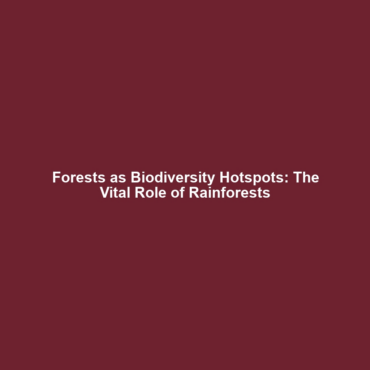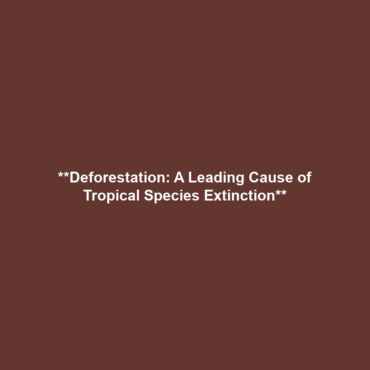The Role of Forests as Biodiversity Hotspots
Category: Deforestation & Biodiversity Loss
Introduction
The tropical rainforest, often referred to as the “lungs of the Earth,” plays a crucial role as a biodiversity hotspot. These rich ecosystems host over half of the world’s terrestrial species, making them pivotal in the global fight against biodiversity loss. Understanding the significance of forests, particularly tropical rainforests, is essential in the broader context of deforestation and biodiversity loss. Protecting these critical habitats is not only vital for preserving species but also for sustaining life on our planet. In this article, we delve into the importance of forests as biodiversity hotspots and the urgent need to address deforestation.
Key Concepts
Forests serve as critical biodiversity hotspots characterized by a high number of different species, many of which are endemic. The following key concepts outline their role:
1. Biodiversity Hotspots
Tropical rainforests are defined as biodiversity hotspots due to their rich variety of plant and animal life, many of which are unique to these regions. The conservation of these ecosystems is vital for maintaining genetic diversity and species resilience.
2. Ecosystem Services
Forests provide essential ecosystem services, including carbon sequestration, climate regulation, and water purification, all of which contribute to broader environmental stability.
3. Threats from Deforestation
Deforestation poses a substantial threat to these biodiversity hotspots, leading to habitat destruction, fragmentation, and a dramatic loss of species.
Applications and Real-World Uses
Understanding the role of forests as biodiversity hotspots leads to various practical applications:
1. Conservation Strategies
Effective conservation strategies are developed by understanding how tropical rainforests function as biodiversity hotspots, helping to prioritize areas for protection against deforestation.
2. Sustainable Resource Management
Sustainable practices in forestry and agriculture are informed by knowledge of biodiversity, enhancing ecological benefits and economic returns.
3. Ecotourism Development
Promoting ecotourism can raise awareness and provide financial incentives for preserving rainforest ecosystems and their biodiversity.
Current Challenges
Several challenges hinder the effective study and application of tropical rainforests as biodiversity hotspots:
- Lack of comprehensive data on species diversity and distribution.
- Political and economic pressures leading to unsustainable land-use practices.
- Challenges in reconciling conservation initiatives with local community needs and development goals.
Future Research and Innovations
The future of research concerning forests as biodiversity hotspots is critical in combatting biodiversity loss:
1. Technological Advances
Emerging technologies such as remote sensing and DNA barcoding are innovating how scientists study and monitor biodiversity in tropical rainforests.
2. Policy Development
Research efforts aimed at developing effective policies for protection can lead to more sustainable practices in land management and resource use.
Conclusion
In summary, the role of forests, particularly tropical rainforests, as biodiversity hotspots is pivotal in addressing the global crisis of deforestation and biodiversity loss. The multifaceted benefits they provide underline the urgent need for conservation efforts. We encourage readers to engage with local and global initiatives aimed at preserving these vital ecosystems. For further information, please refer to our articles on conservation strategies and sustainable forestry practices.

